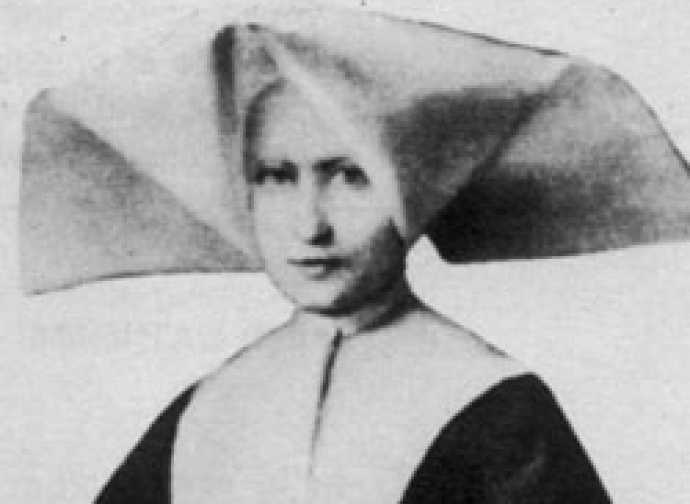Catherine Labouré, how a Daughter of Charity was born
Today, the 31st December, is the liturgical memorial of Saint Catherine Labouré, known for the apparitions of Our Lady of the Miraculous Medal. An explanation of how her vocation was born and why she chose the charism of St Vincent de Paul.

It is well known that St Catherine Labouré (2 May 1806 - 31 December 1876) was graced with the apparitions of Our Lady of the Miraculous Medal in 1830, when the French saint was still a novice in the Paris convent of the Daughters of Charity in the Rue du Bac. Less well known, although there is no shortage of accounts, is her life before entering the institute founded by St Vincent de Paul (1576/81-1660) and St Louise de Marillac (1591-1660), and after the cycle of apparitions of the Blessed Virgin in Rue du Bac, which consisted of three apparitions (in July, November and December), the most famous of which took place on 27 November 1830.
Catherine was born into a large family where everyone called her Zoe (Zoé in French) because she was baptised on the feast of Saint Zoe, although this name does not appear in either the parish or civil registers. The Labourés, who were relatively well-off and lived on a large farm, were hard-working people, willing to make sacrifices and with fervent faith that had not been shaken by the storms of the French Revolution. The ordinary, tiring but serene course of days on the farm was shattered by the death of Madeleine Gontard, the mother of the future saint, at the age of just 46. On the same day, 9 October 1815, Catherine, who was only 9 years old at the time, embraced a statue of the Virgin Mary and, between sobs, said to her: "From now on you will be my mother".
When she was about 12, after her sister Maria Luisa had joined the Daughters of Charity of Saint Vincent de Paul, Catherine found herself the eldest woman in the house. There was a lot of work to be done on the farm - food to be prepared between meals (also for the workers in the fields), cows to be milked, the house to be kept in order, clothes to be washed, produce to be sold at the market, and so on. For the first two years she had the help of a maid, but then, having gained the necessary experience, she no longer needed one.
Despite the many duties of the farm, Catherine always found time to be alone with the Lord. Every day she would go to the church in her village and kneel on the stone floor. It was a church where Sunday Mass was seldom celebrated, for one of the pernicious effects of the Revolution was a shortage of priests. It was in this church, however, that Catherine made her First Communion on 25 January 1818, an event that contributed to her spiritual growth. During Catherine's cause for beatification, one of her nieces (Madame Duhamel), daughter of her sister Tonine, testified: "I learned from my mother that the Servant of God had a great devotion to the Blessed Virgin, especially from her First Communion. My mother also told me that from then on she became completely mystical".
At the age of 14, Catherine began fasting on Fridays and Saturdays. While still a teenager, she felt a clear call to religious life, although one question remained: in which congregation? At the age of 18, she had a special dream: she saw an elderly priest who once told her that "it is good to care for the sick", that she would like to join him one day, and that God had plans for her. "Don't forget that", the vision told her. During a subsequent stay in Chatillon, where she had gone to learn to read and write in order to become a nun, two different circumstances revealed to her the identity of the priest who had appeared to her in the dream: he was St Vincent de Paul.
Catherine, therefore, understood that the Lord was calling her to join the Daughters of Charity. The young woman waited patiently for the time to come, refusing several marriage proposals. Years passed, but her perseverance, always combined with filial love, enabled her to overcome her father's opposition. Finally, at the beginning of 1830, when she was not yet 26 years old, Catherine began her postulancy with the Daughters of Charity, in the community of Chatillon, where for three months she was introduced to the prayers, charism and lifestyle of the great female Vincentian branch. Among the tasks entrusted to her was the distribution of soup to a large number of poor and sick people.
She then moved to Paris, to Rue du Bac, the headquarters of the Motherhouse. A few days after her arrival in the capital, the body of Saint Vincent was solemnly transferred from Notre-Dame to the place where it still rests today, the Motherhouse of the Lazarists (the male branch). Catherine also paid homage to the remains of the saint and asked him to intercede for the institutes he had founded and for the whole of France. It was during these days of prayer in the Rue du Bac that Catherine had a mystical vision of St Vincent's heart. "It appeared to me", she wrote, "three days in a row in a different way: white, flesh-coloured, and this announced peace, serenity, innocence and union. Then I saw it the colour of fire, which is the symbol of charity kindled in hearts. It seemed to me that love would renew itself and spread to the ends of the earth. Finally, it appeared dark red, which put sadness in my heart. I experienced a grief that I could not overcome. I did not know why or how this sadness was related to the change of government".
The dark red heart symbolised the new phase of socio-political upheaval and the new persecutions that would soon hit the Catholic Church in France, starting with the Revolution of July 1830. Yet, the two communities of Saint Vincent were spared from these upheavals, a sign of a special heavenly protection that Our Lady herself foretold in her first apparition to Catherine, a few days before the outbreak of that revolution. On that occasion, Our Lady asked the novice in particular to report that everything possible should be done to "reinstate the original Rule" and to watch out for "bad reading, wasting time, visits...".
The fiery heart was a prophetic sign of the expansion of the Vincentian family. And indeed, after the apparitions of the Mother of God to St Catherine, the minting and distribution of the medal requested by the Blessed Virgin Mary and defined as miraculous by the people - a medal which, even before the definition of the dogma, bore (and bears) the inscription of the truth of the Immaculate Conception - both the Lazarists and the Daughters of Charity experienced an extraordinary increase in vocations.
Catherine lived these and other supernatural experiences - which she shared with her confessor - with great humility, desiring only to do her part for the greater glory of God and out of love for her neighbour. At the beginning of 1831, having completed her period of formation, she was sent to the hospice of Enghien, in Reuilly, a suburb of Paris. She remained there for the rest of her earthly days, a good 46 years, most of which - after five years as a kitchen worker - she devoted to caring for the elderly. «The elderly were sometimes moody, or rough, or stubborn... Catherine did not flinch: her balance, her consistency, her fairness disarmed them. Often the Sisters reproached her for being "too good" and she replied: "I see Jesus Christ in them". Once Sister Charvier, speaking of a particularly difficult elderly man, said: "He's crazy!". Catherine's eyes filled with tears and she was content to reply: "Well, pray for him"» (Caterina Labouré e le apparizioni della Vergine a Rue du Bac, San Paolo Ed., Palmarita Guida).
In 1876, she predicted that she would not live to the following year: it was the last prophecy to be fulfilled in her earthly life, for on 31 December of that year she returned to the House of the Father. By that time, a billion miraculous medals were already circulating throughout the world.




